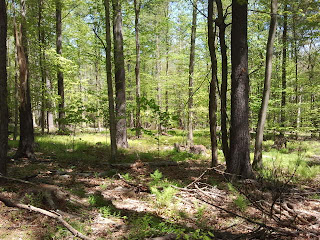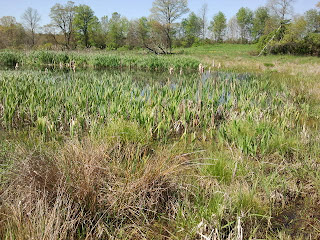A couple of weeks ago, on a nicer day than I could have asked for, I decided to go check out a few UNH-owned sites that I could use for my research. First stop:
Kingman Farm. Crossing a large field, my mud boots sank into the soft, freshly-tilled soil as I carefully avoided stomping on the seedlings of whatever crop had been planted (oats or wheat, maybe). Just past the field I found this patch of forest:
 |
| Forest next to Kingman Farm |
It seemed young, and perhaps recently logged, with lots of sunlight, ferns, tree seedlings, and wildflowers in the undergrowth. I think you can see from the fresh green color of all the leaves that it was a lovely spring day in the woods of NH! In the shady patch to the left of the biggest tree in that photo is where I scooped some moist leaf litter into a Ziploc bag to see what species of mites and collembola I can find at this site.
On the
other side of the newly-planted field was a swampy area with mostly grass and cattails. Each step there made me grateful for my mud boots, as the cool mud and welling water swallowed them up to above my ankles. Behold: Kingman Farm Marsh!
 |
| A view of the marsh at Kingman Farm |
Collecting a sample here was a little trickier, as all of the leaf litter is either very dry from the sun (the top layer of tan leaves you can see in the photo) or, just below the surface, sopping wet and intertwined with other long strands of decaying leaves. Strangely feeling a bit like a zombie with a handful of oozing brains (a bit too much metaphor?) I filled another Ziploc bag just about where I was standing when I took the photo.
Heading over to the
Burley-Demerritt Organic Dairy Research Farm, I ran into a friend who samples gaseous emissions from the soil there; she pointed me toward a particular part of the farm where she said I could find some good marshy action. On the way, some young cows took an interest in me, following me from one side of their paddock to the other:
 |
| Yearling (or so?) cows at the Organic Dairy |
They weren't interested in offerings of fresh grass, and moo-ed plaintively as I walked off. Sorry ladies! I don't have anything better for you... Maybe we can hang out again some other time? Sound good?
A little way from my
Jersey cow friends, I found the marsh my (human) friend had promised. It was anything a girl could ask for: a little pond, cattails, tussocks.... Just perfect!
 |
| The marsh at the Organic Dairy |
Doesn't this part of the vegetation look rather different from the grasses that were in the marsh at Kingman Farm? Being shorter, the decaying leaves from these plants seemed easier to collect, though there was also more muck in my Ziploc bag by the time I had filled it up.
 |
| Marsh vegetation at the Organic Dairy |
From their Ziploc bags, I loaded my leaf/muck samples into some Berlese funnels, which shine a light that heats and dries out the material, much to the chagrin of the critters inside. Trying to find cooler, moister climes, they head downward and fall to the bottom of the funnel where they collect in a little container.
 |
| Berlese funnels (not my photo) |
 |
| Old-timey inventor of these funnels, Antonio Berlese. Gotta love the moustache! |
Interestingly, I found that at both marshes, there were lots of mites but they were only from one species, a very shiny, very round, very black species with kind of a pointy head. Unlike the other mites I've collected so far who seem to wander aimlessly in the containers where I keep them, or merrily while away the hours chewing on leaves, the majority of these bead-like mites gathered in a big cluster and formed a big, shiny, black patch. Then they stood around and did nothing. I wonder if they were actually standing together so they could turn into a mite raft when the water levels in the marsh rise to avoid being flooded by instead floating off to the safety of some taller plants? Much like these fire ants:
 |
| Fire ant rafting behavior (not my photo) |
A unique ability to form living rafts could explain why they're the only game in town in these marshes. In the other places I look for mites, I tend to find quite a few different-looking species, none of which cut it in the marsh, I guess!
On other fronts, I've been calling and emailing folks left and right in an effort to find farmers who will let me sample soil and leaf litter from their land. Every person in agricultural extension agencies, or at other farming organizations, probably grimaces slightly when they hear my name, at this point... But today I made the most headway, as I actually SPOKE to two real farmers, who were super gracious and said I could come by anytime! I think I probably need 5 more sites than that, so the search continues...
Too bad I will probably not be using marshes after all (the single species mite thing kind of rules them out for me...), because I really like those sweet little cows at the Organic Dairy...






